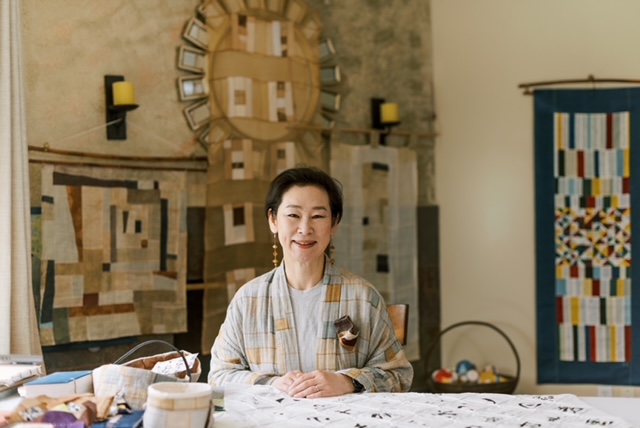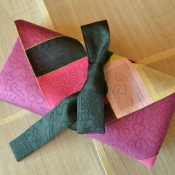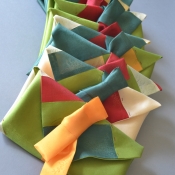Topic: Bojagi (Korean Wrapping Cloths)
Speaker: Youngmin Lee
Website: www.youngminlee.comngminlee.com/
Instagram: www.instagram.com/youngminlee_bojagi/
Youtube: https://www.instagram.com/youngminlee_bojagi/
Facebook: https://www.facebook.com/youngmin.lee.357

Youngmin Lee is a textile artist who uses bojagi tradition and techniques to create her work. Her interest in textiles led her to study Clothing and Textile in college and she received an MFA in Fashion Design in South Korea. She has researched bojagi making and techniques, and endeavors to apply her findings to both in traditional and contemporary art. After she moved to California in 1996, she has actively worked on preserving the bojagi tradition that embodies the philosophy of recycling and up-cycling, as the works are made from pieces of fabric left over from other projects.
She is working closely with Asian American community with community engaged projects and workshops at the Asian Art Museum, Los Angeles County Museum of Art, and Saint Louis Art Museum. In addition to teaching in person, Youngmin created the educational DVD, Bojagi: The Art of Wrapping Cloths in 2013 to reach people from afar. She teaches at the local public school to introduce and educate Korean traditional textile art. She received the grant from Alliance for California Traditional Arts Apprenticeship in 2019 and 2022 as a mentor artist and taught bojagi to her apprentice. Her new book, Bojagi: The Art of Korean Textiles with Techniques and Project, is coming in 2024.
She founded the Korean Textile Tour in 2017 to introduce Korean traditional textile art and culture to bridge broader audiences. Youngmin’s works have been exhibited and collected throughout the United States, South Korea, UK, Romania, and Turkey. The Asian Art Museum of San Francisco has her works in the museum collection.
Bojagi (Korean Wrapping Cloths) are pieced together from small scraps of cloth. It is the most unique form of Korean textile art. Bojagi occupied a prominent place in the daily lives of Koreans of all classes. They were used to wrap or carry everything from precious ritual objects to everyday clothes and common household goods also to cover food. It is strikingly contemporary: the designs and colors of bojagi remind one of the works of modern abstract artists. Bojagi can be described as a true form of abstract expressionism.
Youngmin Lee will talk about bojagi during this lecture and show her bojagi works after the lecture.



Title: Exploring the Artistry of Korean Bojagi and Ssamsol Jogakbo
Introduction:
Korea boasts a rich cultural heritage that extends beyond its delectable cuisine and ancient traditions. Among the lesser-known treasures of Korean culture are the exquisite textile arts, with bojagi and ssamsol jogakbo standing out as true masterpieces. These traditional Korean patchwork techniques have been passed down through generations, embodying the essence of craftsmanship and artistic expression.
Bojagi:
Bojagi, also known as pojagi, refers to a traditional Korean wrapping cloth that originated centuries ago. These colorful and intricately designed textiles were initially used to wrap and carry items, acting as both functional and decorative pieces. Over time, bojagi evolved into a unique form of textile art, featuring a distinctive patchwork style that reflects the creativity and skill of Korean artisans.
What sets bojagi apart is the meticulous stitching and piecing together of various fabric remnants, creating a harmonious blend of colors and patterns. Commonly made from silk or ramie, bojagi often features geometric shapes, nature-inspired motifs, and vibrant hues. The art of making bojagi requires precision and patience, as each piece is carefully crafted to achieve a balanced and visually appealing composition.
Ssamsol Jogakbo:
Ssamsol jogakbo, another form of traditional Korean patchwork, shares similarities with bojagi but stands out with its unique three-layered construction. “Ssamsol” translates to “three layers,” and “jogakbo” refers to a patchwork quilt. This technique involves stacking three layers of fabric and then cutting and reassembling them to create a stunning geometric pattern.
The intricate design of ssamsol jogakbo often reflects the natural world, incorporating elements like flowers, butterflies, and birds. The layering of fabrics not only adds depth and texture but also allows the play of light and shadow, enhancing the visual appeal of the finished piece.
Preservation and Modern Revival:
While these traditional Korean textile arts have deep historical roots, contemporary artisans and enthusiasts are working to ensure their preservation and revival. Specialized workshops, exhibitions, and cultural initiatives celebrate the beauty of bojagi and ssamsol jogakbo, introducing these artistic traditions to a wider audience.
In a world increasingly dominated by mass-produced goods, the handmade and culturally rich nature of bojagi and ssamsol jogakbo offer a refreshing glimpse into Korea’s heritage. These unique textiles not only tell a story of the past but also inspire a new generation of artists to explore and reinterpret these traditional techniques in a modern context.
Conclusion:
Korean bojagi and ssamsol jogakbo stand as testament to the country’s deep cultural heritage and artistic ingenuity. The vibrant colors, intricate patterns, and meticulous craftsmanship embedded in these textiles capture the essence of Korean creativity. As efforts continue to preserve and promote these traditional arts, the world is given the opportunity to appreciate and marvel at the timeless beauty of bojagi and ssamsol jogakbo.
Note: The above article was generated by ChatGPT